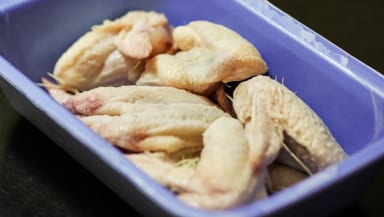Is It Better for the Environment to Eat Beef or Chicken
It's true that producing beef has a hefty environmental impact. Forests are destroyed to provide grazing land and grow soya to produce cattle feed, which releases huge amounts of carbon.
But chicken also has a huge impact. Around the world, the amount of chicken being eaten has rocketed, almost doubling in the last 30 years. Today, more chicken is eaten than beef, and there are billions of chickens being reared for eggs and meat.
All these chickens need feeding. Most are kept in intensive factory farms, where they're provided with processed, concentrated feed made largely from soya. Much of this soya comes from South America, grown in areas which, not long ago, were forests or savannahs. Now, they're huge soya bean plantations.
There are now 30 chickens for every 10 people on the planet. There are so many chickens, the balance of nature has shifted. Farmed chickens and other poultry make up 70% of all birds on Earth (measured by biomass, or the weight of living organisms). Rearing animals for food is literally squeezing out nature, leaving no space for wild animals.
As things stand, chicken consumption is only going to increase. Eating habits across the world are changing, and more people are eating more meat. Influenced by modern western diets, China, India and other countries are shifting from traditional balanced diets to ones heavy in meat and dairy.
Destroying forests to feed chickens
Huge amounts of soya from Brazil end up in the EU, which is the second biggest importer of soya in the world. Most of this is used for animal feed, and half of that is fed to chickens. The UK alone imports over 3 million tonnes of soya per year.
The animal feed industry is doing untold damage to many of Brazil's natural landscapes, including the Cerrado. This vast savannah, characterised by dry grasslands dotted with trees, contains a bewildering variety of plants and animals. It's also known as the "cradle of waters" as it feeds most of Brazil's major rivers, including the Amazon.
South America's second largest forest, the Gran Chaco, is also being devastated by soya, as well as cattle ranching. Jaguars, armadillos and giant anteaters roam among the thorny shrubs of this dry tropical forest. However, the Gran Chaco is disappearing faster than any other forest as industrial agriculture expands into the region.
The Amazon rainforest is currently protected from being turned into soya plantations. In 2006, a ground-breaking deal ended the destruction of the Amazon by soya companies. The deal is still in place, but those same companies who signed up are now destroying the Cerrado and the Gran Chaco.
By destroying these natural landscapes, food companies are making a big contribution to the climate crisis, as well as threatening wild species with extinction. The way our food is produced and distributed generates nearly a quarter of all emissions produced by human activity, and the meat and dairy industry is the most damaging.
The demand for cheaper animal products and, as a result, cheaper animal feed is encouraging the soya industry to push further into the Cerrado and Gran Chaco. Soya production in Brazil has ballooned – it produces four times as much as it did 20 years ago.
Produce less chicken to tackle climate change
Many people have shifted from eating beef to chicken as a more climate-friendly option. But the sheer numbers of chickens eaten means they make a big contribution to climate change, along with the additional pollution generated by factory farming. So shifting from beef to chicken is not the answer.
Instead, we all need to cut down the amount of meat and dairy we eat. Cutting back on meat, cheese and milk will mean fewer cows, pigs and chickens. That also means less land will be needed for grazing and growing soya, leaving more space for forests and wildlife. To meet climate change targets, global meat and dairy consumption will need to fall by 50% by 2030.
In a country like the UK, we already eat way above the world's average levels of meat. That means replacing 70% of the meat and dairy eaten in this country with plant-based options over the next 10 years.
Like all meat, chicken is contributing to climate change and the destruction of nature. We can all make changes in our eating habits to include more beans, fruit and vegetables. But the real change will only come from food companies. They decide what food is on the shelves and, through advertising and special offers, have a huge influence on what shoppers choose to buy.
If we're serious about tackling the climate and nature emergency then food companies and supermarkets need to start replacing the meat and dairy in their products with healthy, affordable plant-based foods.

People often opt for chicken over beef for environmental reasons. But new Greenpeace research shows that the chicken sold in the UK is a major driver of deforestation, and supermarkets have little idea of the impact this has on forests. Here are the facts.

Brazil's environment minister Ricardo Salles went on a tour of the US and Europe to reassure governments and business over the fires crisis in the Amazon. It did not go to plan.

The Amazon is on fire and global fast food companies can put a stop to it. They must stop buying meat, chicken and soya from Brazil until the Amazon and its people are protected.
Source: https://www.greenpeace.org.uk/news/is-eating-chicken-better-for-the-environment-than-beef/
0 Response to "Is It Better for the Environment to Eat Beef or Chicken"
Post a Comment